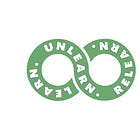Insatiable Curiosity
Finding a North Star for Thinking
Welcome to Polymathic Being, a place to explore counterintuitive insights across multiple domains. These essays explore common topics from different perspectives and disciplines to uncover unique insights and solutions.
Today's topic is one more of our Mixed Mental Arts that addresses a core element of our Systems Thinking philosophy. Insatiable curiosity is more than just interest in topics, it’s a way to explore yourself, engage with others, and challenge the world. Come join us as we dive in.
🎧Prefer to listen? You can find these essays on all major podcast players!
Intro
When Jeff Bezos stepped down as the CEO of Amazon, he left them with a memorable quote: “Let Curiosity be your compass.” As the founder of a company that revolutionized logistics, it’s great to see how he led with the idea of curiosity, and it demonstrates just how powerful that concept is!
You’ll also recognize that it’s part of the foundational trifecta of Systems Thinking, where we combine:
Insatiable Curiosity
The Humility to accept that we don’t know as much about the system as we think.
Intentional Reframing of the problem (The Enemy’s Gate is Down)
We’ve covered Humility before with the need to Embrace our Whitebelts and heed the words of Plato when he said: "The only thing I know, is that I know nothing.” As aspiring polymaths, we build on that idea as a method to avoid hubris, where:
Our White Belt reminds us of the three most powerful words we can apply here: “I don’t know”. This drives us to challenge everything we thought we knew and gives us the freedom to explore the world.
That freedom to explore is the lifeblood of insatiable curiosity. It’s also the confidence to challenge the status quo, step outside our lane, and stretch our brains in ways that unlock incredible innovation. Let’s take a moment and explore this power.
Curiosity
I’m sure we’ve all heard that “curiosity killed the cat,” “the genie can’t be put back in the bottle,” “don’t go down the rabbit hole,” “beware Pandora’s box,” and many more warnings about being curious. I’ve certainly experienced my fair share of gatekeeping when others don’t feel it’s appropriate for me to explore different domains and disciplines. Even when we raise our children, we can easily suffocate their natural curiosity through apathy, fear, or just laziness. It feels like we are surrounded by a world that feels, as Thomas Gray says: “Where ignorance is bliss, ’tis folly to be wise.”
On the one hand, curiosity is absolutly natural. On the other hand, curiosity takes a lot of energy and can be difficult.
How difficult? Well, they don’t say “Ignorance is Bliss” for no reason. It’s shockingly difficult to be truly curious, let alone insatiably curious. Let me try to break it down a bit. Often, we are marginally curious. We have very structured comfort zones, and we tend to like things that confirm our beliefs. For instance, growing up, I was encouraged to be curious about the Bible. When I took this to heart and embarked on a theological journey, I quickly discovered that curiosity was valued in that church, provided it led to discoveries that supported the established dogma. Anything else was to be avoided, ignored, or rejected.
Another element is that we love to be curious about other people, especially their foibles, but we have almost zero curiosity about how we work ourselves. What I find most valuable about writing here each week is that it allows me to share these counterintuitive insights with you, which I first explored within myself. That’s not easy because you’ll quickly realize how right Plato was. Truly, the only thing I know is that I know nothing. That's why I wrote about humility before delving into a deeper analysis of curiosity. You’ve got to get over your own ego to be truly curious.
Now, insatiably curious is a whole other animal. It’s an active stance that moves beyond just the humor of what others are doing or the introspection of yourself. Insatiable curiosity is the drive to really look across, between, and under topics to find the truth, regardless of how uncomfortable it really is. It’s also an active challenge that keeps me on my toes because there’s always more to learn, unlearn, and relearn.
The benefits are incredible, as
wrote a while back:Curiosity is a bio-hack. As Dr. Huberman points out, the act of getting curious releases dopamine, serotonin, and norepinephrine simultaneously to produce a unique effect on the human body and brain. Learning how to harness and leverage this “hack” gives you a tremendous advantage in getting more done in whatever you are doing and finding greater satisfaction in what comes from it.
This bio-hack crosses all mental domains, from boosting attention, memory formation, and recall,12 to mental and emotional well-being with improved life satisfaction, and a sustained sense of meaning.3 Even better, it improves social connection, helping people create closeness by being curious.4 It even improves physical stress physiology with links to more adaptive cardiovascular responses to acute stress.5
With that powerpack of benefits, it’ll be no surprise that it helps with cognitive aging by supporting continued engagement and mental health.6 Higher curiosity predicts better survival and lower mortality risk in older adults.78 With all this in mind, let’s take a look at how to build this superpower.
Be Curious
I have to caveat here that personality proclivities add a bit of a monkey wrench into the mix. As I shared in one of my original essays, I’m extremely high in Openness and very low on Neuroticism on the Big 5 Personality profile. That means I’m inclined to appreciate new ideas, information, and experiences without much worry. Conversely, someone who is very low on openness and very high on neuroticism is going to find this challenge significantly harder than I.
That caveat aside, simply put, I’d distill it down to three steps to begin unlocking your curiosity.
Understand who you are. Be curious about that brain of yours first. Explore your biases, your blindspots, your glitches, and your beliefs.
Then recognize that we are surrounded by people who can challenge us to grow, improve our ideas, and leverage humanity’s superpower of social learning.
Finally, work to help others around you to grow their curiosity and build your own insatiable curiosity into a gravity well that draws others in, motivates them, and, in turn, exposes you to new ideas and insights.
For many, our natural curiosity is tempered by the fear of the unknown or the fear of challenging what we do know. Research shows that three fears limit curiosity, and therefore innovation: fear of criticism, fear of uncertainty, and fear of negative career impact. I can attest that there is truth to these fears, as curiosity has caused this cat to be attacked more than once. Counterintuitively, facing these fears also helps you find the solutions to address those fears, and that’s courage coupled with curiosity
Another resource for unlocking curiosity comes from
who shows that we can become curious about anything when we get ourselves in the right mental headspace and allow ourselves to explore. Sometimes that’s getting back to a child-like sense of awe and reverence about the world around us, and sometimes it’s being irreverent to a closely held belief to break a paradigm in order to free yourself to think differently.It might be intimidating to challenge yourself like this, but it’s the antidote to so much of the frustration I see. Whenever I’m down or frustrated, my first inclination is to explore, and in doing so, I often find that it’s either not as bad as I thought, there’s a solution out there that can fix it, or I don’t even have to be dealing with it to begin with. But it takes that curiosity to move and find out one way or the other.
Insatiable curiosity is my compass, humility is the fuel that drives it, and intentional reframing and the discovery of counterintuitive insights is the reward. It’s all a core of Mixed Mental Arts and Systems Thinking that underpin what we explore here. Curiosity may have killed the cat, but satisfaction brought it back.
Did you enjoy this post? If so, please hit the ❤️ button above or below. This will help more people discover Substacks like this one, which is great. Also, please share here or in your network to help us grow.
Polymathic Being is a reader-supported publication. Becoming a paid member keeps these essays open for everyone. Hurry and grab 20% off an annual subscription. That’s $24 a year or $2 a month. It’s just 50¢ an essay and makes a big difference.
Further Reading from Authors I Appreciate
I highly recommend the following Substacks for their great content and complementary explorations of topics that Polymathic Being shares.
Goatfury Writes All-around great daily essays
Never Stop Learning Insightful Life Tips and Tricks
Cyborgs Writing Highly useful insights into using AI for writing
Educating AI Integrating AI into education
Socratic State of Mind Powerful insights into the philosophy of agency
Gruber, M. J., Gelman, B. D., & Ranganath, C. (2014). States of curiosity modulate hippocampus-dependent learning via the dopaminergic circuit. Neuron, 84(2), 486–496.
Padulo, C., Marascia, E., Conte, N., Passarello, N., Mandolesi, L., & Fairfield, B. (2022). Curiosity killed the cat but not memory: Enhanced performance in high-curiosity states. Brain Sciences, 12(7), 846.
Kashdan, T. B., & Steger, M. F. (2007). Curiosity and pathways to well-being and meaning in life: Traits, states, and everyday behaviors. Motivation and Emotion, 31(3), 159–173.
Kashdan, T. B., McKnight, P. E., Fincham, F. D., & Rose, P. (2011). When curiosity breeds intimacy: Taking advantage of intimacy opportunities and transforming boring conversations. Journal of Personality, 79(6), 1369–1402.
O’Súilleabháin, P. S., Howard, S., & Hughes, B. M. (2018). Openness to experience and stress responsivity: An examination of cardiovascular and underlying hemodynamic trajectories within an acute stress exposure. PLOS ONE, 13(6), e0199221.
Sakaki, M., Yagi, A., & Murayama, K. (2018). Curiosity in old age: A possible key to achieving adaptive aging. Neuroscience & Biobehavioral Reviews, 88, 106–116.
Swan, G. E., & Carmelli, D. (1996). Curiosity and mortality in aging adults: A 5-year follow-up of the Western Collaborative Group Study. Psychology and Aging, 11(3), 449–453.
Turiano, N. A., Spiro, A. III, & Mroczek, D. K. (2012). Openness to experience and mortality in men: Analysis of trait and facets. Journal of Aging and Health, 24(4), 654–672.










Excellent essay! This approach builds a highly productive and positive
work culture. Good leaders support this by reducing the fears and asking thoughtful questions to stimulate curiosity.
You made me look into a mirror and go, “oops!”. Two thoughts, if I may. I recall as a kid going out at night, lying on my back, looking at the stars and wondering if there was some kid out there on a planet around some distant star looking at the same sky. Looking in that mirror I realize I’ve lost that sense of curiosity and wonder I had so many years ago. Thank you for reminding me.
There’s curiosity and there’s curiosity. I find myself holding my alternate brain and hopping from topic to topic on the Internet. I too frequently rationalize the time I spend doom scrolling saying to myself that this is curiosity and I’m learning. Perhaps there’s some truth to that, I’m not sure exactly how to explain the difference, but it seems to be curiosity and it’s close cousin wonderment need to be more active. My brain says to me, there’s a difference between scrolling the Internet and holding a book in my hand. I don’t know how to explain it, but I think it’s true.
Thank you Michael for encouraging my feeble brain to get off it butt and start exploring… and wondering.